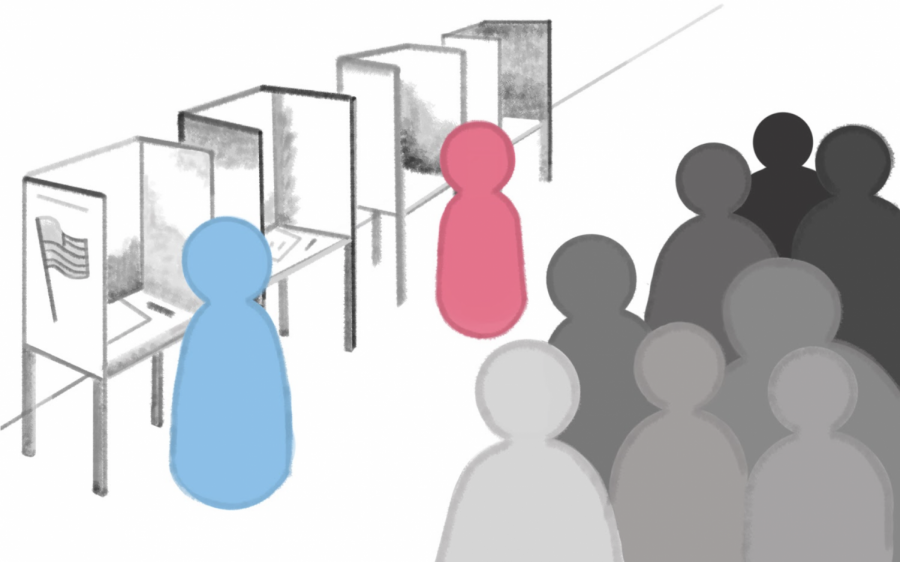Americans Don’t Vote, but They Should
American politics revolves around the Democratic and Republican parties; but according to NPR, Americans prefer government between the center. Pushed to choose between two extremes, many do not vote at all.
In 1997, my Korean-born parents set off for the United States with a luggage carrier between them. They are now American citizens. My mom watches Hollywood movies without Korean subtitles to decode for her; my dad eats grease-oozing hamburgers without chasing them down with kimchi. They pay their taxes duly, as well as the occasional speeding ticket. Yet in all 23 years they have lived in America, my mother and father have never voted in a single presidential election.
“Why don’t you vote?” I asked my parents in 2016. On TV, Donald Trump was being sworn into office.
“Ah, nothing changes,” my dad said. “Taxes stay the same.”
In a study by the Pew Research Center, turnout rates were compared for voting age populations across members of the Organisation for Economic Co-operation and Development (OECD). America ranked 30 out of the 35 with an election voter turnout of 56%, a stark contrast to Turkey’s 89% and Australia’s 80.8%.
As it turns out, my parents are not alone in bypassing the quadrennial elections. Americans do not vote because of lack of federal enforcement and government representation—but should since presidential administrations leave long-term impacts.
Causes of Low Voting Turnout
A clear body of evidence demonstrates that government enforcement, or lack thereof, impacts voting turnout significantly. The Pew Research Center recorded that countries that either made voting compulsory or automatically registered voters experienced higher voting turnout of around 60 to 70 percent.
But what happens when existing enforcement is removed? According to Drew Desilver from the Pew Research Center, when Chile enforced compulsory voting, it enjoyed a high voting turnout rate, reaching 87% in 2010. However, these numbers plummeted to 42% in 2018 and stayed low in subsequent years when voting became non-compulsory. No confounding variables were present; nothing else about the election changed.
Chile’s situation shows that the relationship between voting turnout and federal enforcement is not just correlation, but clear causation — eliminating federal enforcement lowered voting turnout. In America, the federal enforcement of voting does not exist, so it is only natural that fewer people vote.
Additionally, in America citizens may feel unrepresented by the government.
“Most of the representatives don’t look like me, don’t sound like me, don’t come from where I come from and don’t represent who I am,” a non-voter said in a focus-group discussion held by the Knight Foundation.
Non-voting Americans do not trust their politicians to represent them; they find no reason to vote when politicians do not advocate for the causes they care about. The distrust is only corroborated with the dominance of the Republican and Democratic parties. Political ideologies of Americans lie between conservative and liberal, but in presidential elections, winners are chosen exclusively from either side. When pushed to choose between the two extremes, some simply do not vote at all.
Impacts of Presidential Action
Political power is like a pendulum that swings between the Democratic and Republican Parties. The University of Berkeley recorded this swing by tracking the majority party in Congress from the election years 1980 to 2016. Sometimes, it swung far right; sometimes, it swung far left. But it never strayed too far from the middle.
When a president comes into office, their political efficiency depends on whether the pendulum of power within the Senate and the House has swung towards their own party. Obama’s second term of presidency was when Republicans held a majority in the House of Representatives, which hindered his efficiency.
“There seemed to be some sort of organized effort to try and build as many roadblocks as they could in front of moving any agenda of the president forward,” former Congressman John Boccieri said in an interview with NPR.
As Obama pushed for his Democratic agenda, the Republican majority in the House of Representatives pushed back; our government was stuck in a grid-locked game of tug-of-war.
It’s easy to understand why opponents ask: why does voting matter, if everything stays the same? After each administration, there is always the next one to make amends or reverse the changes made. This argument is true to an extent — the Trump administration left the Paris Climate Agreement signed by the Obama administration. The Biden administration has rejoined it, according to CNBC. But the argument does not account for the crucial fact that there are some irreversible consequences from presidential action.
Environmental Consequences from the Trump Administration
According to research from Harvard Law School and Columbia Law School, the Trump Administration repealed 80 environmental protection laws, with 20 more in progress. Among these, rule reversals on air pollution and emissions make up the greatest amount, which is significant in the face of climate change.
According to Coral Davenport of the New York Times, Trump’s four years of presidency marked a closing window in which world economies could have “charted a path toward slowing the rate of planet-warming emissions.”
Instead, to save the automobile and fossil fuel industries, Trump repealed the environmental protection laws when they were most needed.
“Historically, there is always a pendulum to swing back and forth between Democratic and Republican administrations on the environment, and, theoretically, the environment can recover,” Harvard professor of environmental law Jody Freeman said in an interview with New York Times. “You can put rules back in place that clean up the air and water. But climate change doesn’t work like that.”
No matter if the next administration re-establishes the carbon emission laws, the damage is already done. Greenhouse gases remain trapped in the atmosphere for several decades, and the situation is irreparable—Trump’s presidential legacy is an environmental consequence that affects us all.
Voting Turnout Affects Politics
The politically active minority disproportionately represents the American population. According to the Pew Research Center, “nonvoters were more likely to be younger, less educated, less affluent and nonwhite.”
The Knight Foundation corroborated this research and added that non-voters were more likely to align with Democratic values.
“If the party is able to reshape the electorate with new arrivals to the state — including young people, Latinos and Asian-Americans — as well as greater participation from Black residents and immigrants, a red state becomes a blue one,” wrote Astead W. Herndon, political reporter from the New York Times.
Herndon’s analysis implies that if non-voters vote, more Democratic representation would be present in each state, shifting from red to blue. It is a theory recently supported by Biden’s win in the 2020 election, where Michigan, Pennsylvania and Wisconsin turned blue.
Clinton and Biden both campaigned with moderate progressive ideas and ran against the same opponent; however, Biden won, and Clinton lost.
According to Adrian Blanco and Ted Mellnik from the Washington Post, the key difference was the voting turnout, which was the highest seen in over a century. Most of the first-time voters voted for Biden: in the National Exit Polls, 64% of first time voters reported voting for the Democratic candidate. The Washington Post posits that these first time voters gave Biden a boost in about 960 counties across the United States, enabling him to win the presidency.
In this way, the act of voting is powerful: had non-voters been motivated to vote in 2016, Clinton might have also won the 2016 presidency. Had non-voters voted, Trump may never have had the power to repeal the emission rules: there is a chance we could have averted his lasting legacy of climate crisis.
With each presidential administration, there are irreversible changes that occur. So voting is an act of expression. You take part in choosing the change-making group, advocating for the one you align most closely with.
The midterm election will be held in 2022, and the presidential election in 2024. I will educate myself on the causes each candidate supports and elect with care. I urge my fellow non-voting Americans to do the same; it is our lives that are being decided after all.
Your donation will support the student journalists of Portola High School. Your contribution will allow us to purchase equipment and cover our annual website hosting costs.







Grace Shao | Mar 1, 2021 at 1:01 pm
Love it!!! Great writing Erin
Chloe Lim | Feb 6, 2021 at 12:10 am
beautifully written! I’ll see you at the polling station in 4 years